note on all the image scans: they are correct manga-style so they are read right to left
Spend enough time doing critical readings of media and you come across the assertion that all media tells you about the culture it was written in. Sometimes, as in contemporary media, this is easy to tease out. Other times, as with science fiction, it’s by extrapolation. So I thought it might be interesting to re-read Love Hina, by Ken Akamatsu, as a way to to understand Japanese culture. Part One can be found here.
The Story
The last story of book 1 focused on Motoko. The first story of this book focuses on Kaolla Su. As you can see throughout the manga (but which REALLY shines in the anime) Kaolla Su is a giant ball of energy, figuratively speaking (A Genki Girl). We learn that the only member of Hinata House who’s able to keep up with her is Motoko. Motoko has to go to kendo camp, so Kaolla decides to follow Keitaro and Naru around. Of course, they’re both desperately trying to study for their exams, so Kaolla’s presence is a bit of a problem. Eventually she ends up sleeping in the same room as them because she misses her older brother and sister back in not-India. This results in some humor as she ends up hugging Keitaro and Naru assumes the worst.
There’s a Christmas celebration, which I’ll talk more about later. Then, after seeing Naru in a state of undress for the umpteenth time, Keitaro is sent to fix the hole in her floor right above his room. He gets clumsy and ends up knocking the shelf that holds her diary. This combined with the foreshadowing I mentioned from the first book leads Keitaro and the reader to think that Naru is the girl he promised to meet at Tokyo University.
Keitaro fails the mock exam horribly and decides to leave. The girls decide to try and convince him to come back and we learn that Naru used to be bad at school. It is through dedication that she’s become #1 in the nation. After that they celebrate the New Year by visiting temples.
The night before their first round of tests (apparently there are at least two rounds they have to pass to get into Tokyo University), Kitsune throws them a good luck party. Everyone gets drunk so Keitaro and Naru are late for the one thing they’ve been spending months studying for. They try to catch a bus to the test and end up in the back of a shipping truck. You think they’re going to end up somewhere else in Japan, but Akamatsu’s just messing with us. They end up right outside the testing site.
They both pass the Center Exam, but the girls, though comedic misunderstanding, think he failed. They’re all starting to warm up to him as a friend and they don’t want him to feel bad, so they offer him some fan service. I’ll talk about that some more later. Next up is a story about Valentine’s Day in which Shinobu, who has developed a crush on Keitaro, tries to give him some chocolate, but she’s really nervous and keeps getting interrupted.
Finally, the second exam starts and the book ends.
Life in Japan
As I mentioned in the previous post, Japan is very monocultural so it’s definitely odd to have Kaolla Su, a foreigner be a main character in the book. Ken Akamatsu uses her as the Innocent Fanservice Girl in the same way that Starfire was when she first appeared in Teen Titans. So she thinks it’s ok to jump onto Keitaro in such a way as to leave his face in her crotch or is willing to flash him her panties while Naru frantically tries to get her to stop. It’s a pretty common manga trope for the foreigner to be the more sexual one either purposely or, in the case of Kaolla, because she has a different set of sexual mores. Although, as far as I know this has nothing to do with Indian culture and probably nothing to do with Japanese views of Indian culture – she’s just the outsider. While I was doing research for this section, I came across the spoiler that this also happens later with an American character so either the Japanese believe that all outsiders do stuff like this or that it’s just easier to have the “other” act this way
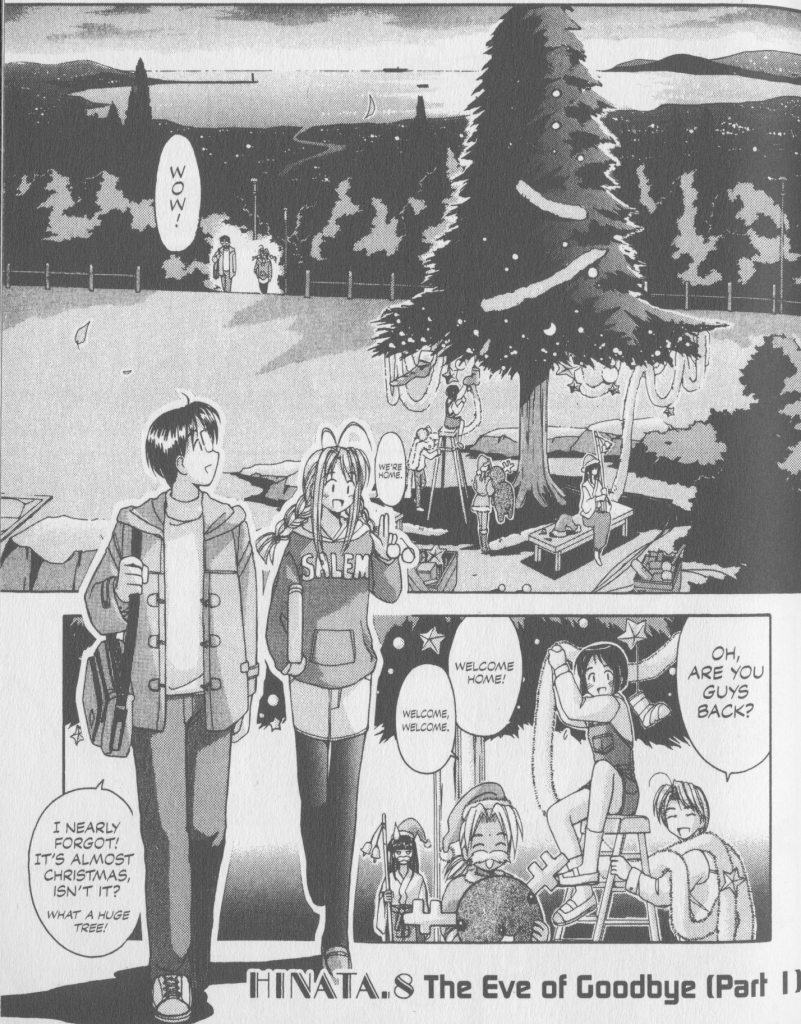
It may surprise some people that the Christmas is celebrated in Japan, given that most of them are either Shinto, Buddhist, or without religion. (Which, I’m not sure, culturally, would count as atheism. It appears to be more of a nonchalantness rather than an outright belief in the absence of gods) However, the Japanese have no problems co-opting the secular Christmas rituals and having a reason to buy each other some gifts and decorate some trees. It’s also a time to really be with that special someone as we see. Doing some research to see how well the book hews to the norm, I also found out that, through marketing, KFC has become associated with Christmas dinners in Japan.
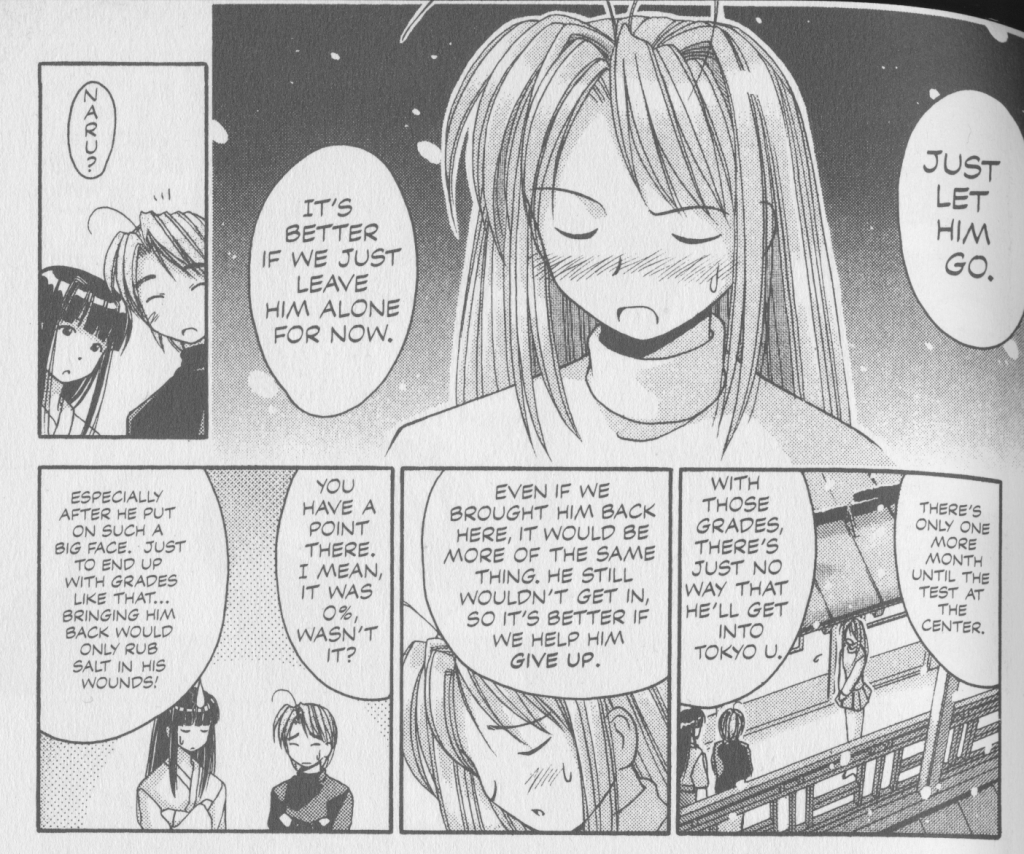
We have an interesting moment early on in this book when Naru tells the girls not to search for him when he runs away. Just let him give up. There’s no chance he’d get in. In fact, despite becoming more and more friendly with the tenants at Hinata House, the girls are constantly telling him to just give up. (They DO also encourage him at appropriate times – like wishing good luck on the day of the test. They aren’t cruel!) This scene stood out to me because I was picturing the equivalent American movie or comic. Sure, there are always some people that don’t believe in the protagonist for some extra drama, but usually it wouldn’t be the love interest or his closest friends. I wonder what this says about the Japanese culture vs American culture. Is there more of a realism in Japan vs idealism in America? Is it just the opinion of Ken Akamatsu?
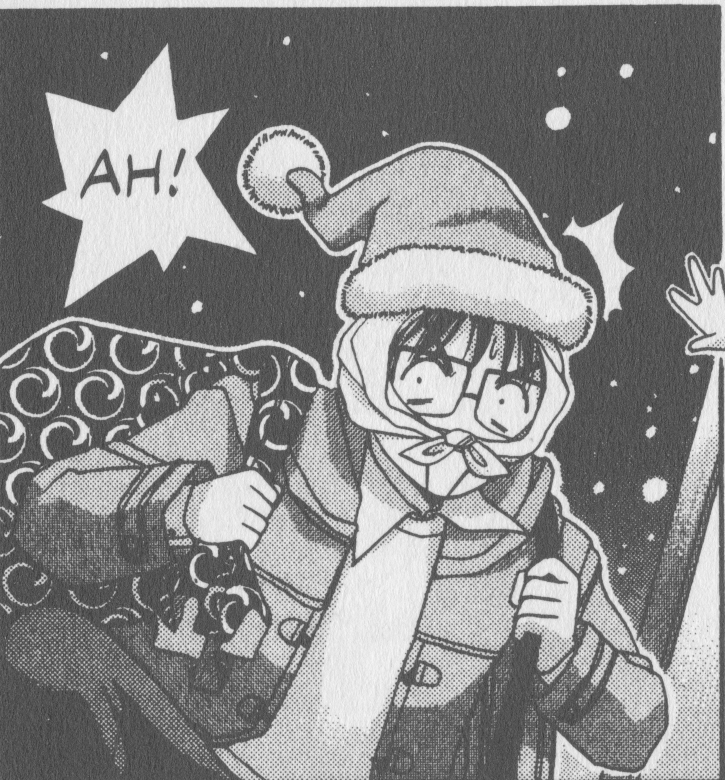
This is just a quick question – why is THIS the way people sneak around in Japan? In American media they’d either have ski masks or something else that would obstruct their face. Manga/anime, on the other hand, has them tie a handkerchief around their face. Why is this a disguise? It seems to me that you’d still be pretty identifiable, but maybe I’m wrong. Or is it a reference to some famous manga or live action scene?
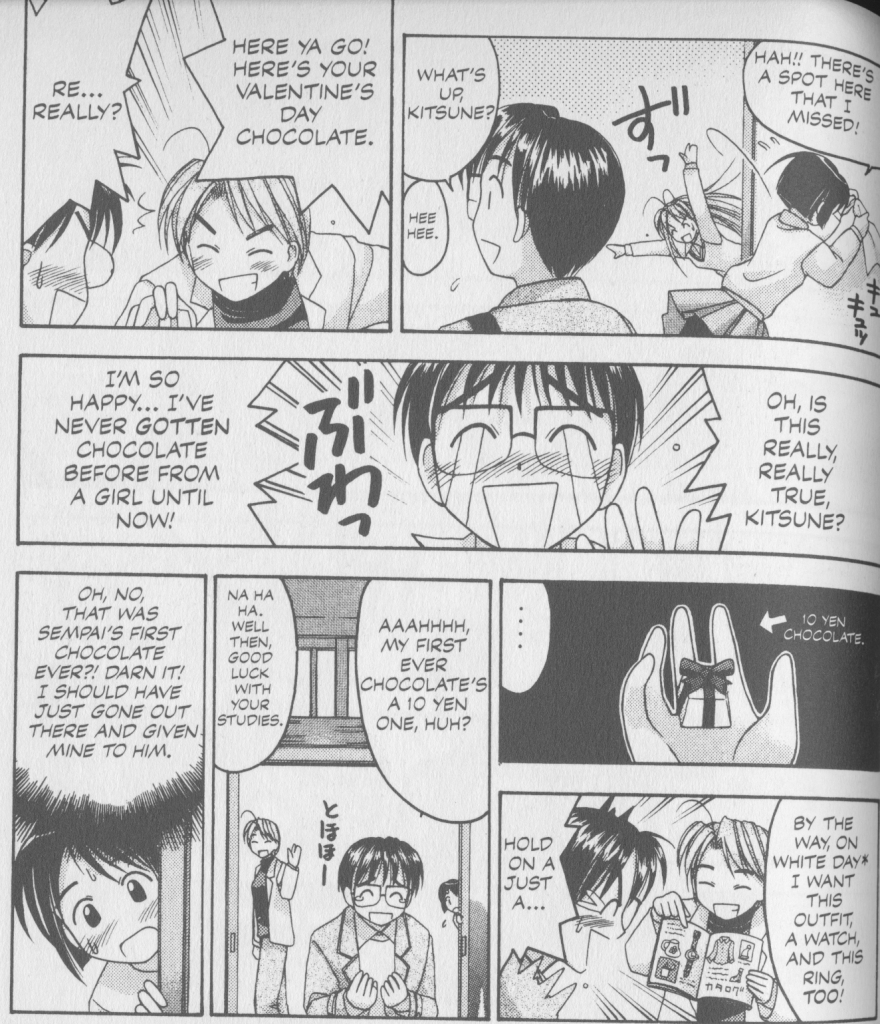
While I was not surprised about the Japanese celebrating Christmas – having heard about it both within Japanese media and in documentaries, I was surprised about Saint Valentine’s Day. However, as depicted in Love Hina, the Japanese don’t give each other cards, as we do. They give each other chocolates. And, again, this may just be based on the situation that Akamatsu has created here, but there appears to be a focus on baked chocolate goods while in America we just give a box of chocolates. Additionally, since Keitaro makes himself a cake (more on that later), it appears that any chocolate food would be fine whereas, again, in America we usually just give chocolate candies. However, this is a global culture so I shouldn’t be so surprised to see the Japanese adopt Valentine’s Day. However, they went ahead and make it uniquely Japanese. First of all, they have two different terms for your chocolate present – signifying whether it was girlfriend chocolate or friend/coworker chocolate. Second, they have completely flipped Valentine’s Day from the way we celebrate it here. In Japan, girls give the guys presents on Valentine’s Day. While there can be reciprocal gift giving in America, it tends to be focused on what the guy is doing for the girl. And, at least in popular media, what the guy gets from the girl is sexual in nature – maybe she wears something special to bed. But, it’s not as thought Japan has forgotten the ladies. As you can see in the above panels, guys get girls gifts on White Day. The one nice thing about it being separated like that is that the guys are reciprocating. So rather than giving each other gifts that are out of proportion, the guy can give a gift that matches what he gets on Valentine’s Day.
Gender/Sex Norms
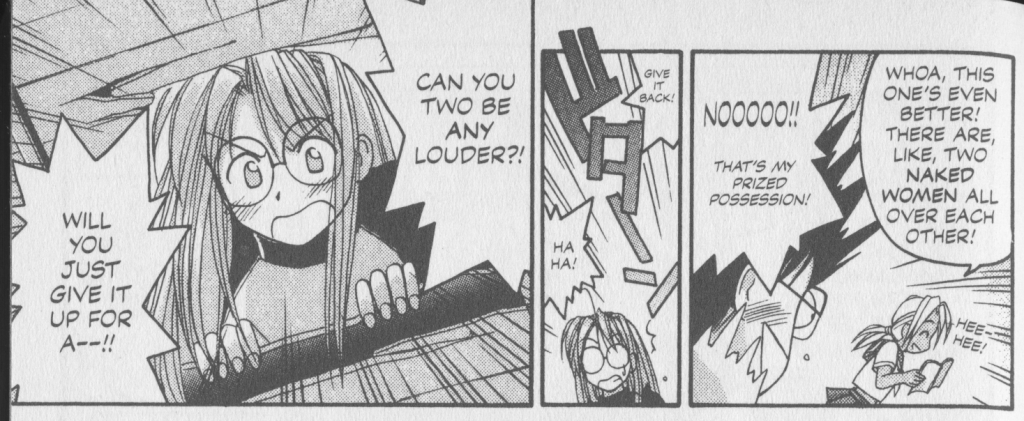
When Kaolla Su is bugging Keitaro and Naru early on, she finds his pornography stash. (Again, something you never see in mainstream American comics, but which you know for some portion of the population it should be the case) Interestingly, she mentions that Keitaro likes female on female porn. The reason I find this interesting is that I have always been fascinated that some straight people would be titillated by what is ostensibly gay porn. I figured it was a cultural thing – uniquely American or Western. I know it doesn’t apply to everyone, so I figured it was a learned fetish – one that people have because they’re supposed to have it. So we’ve either exported that to Japan or it’s more universal than I thought.
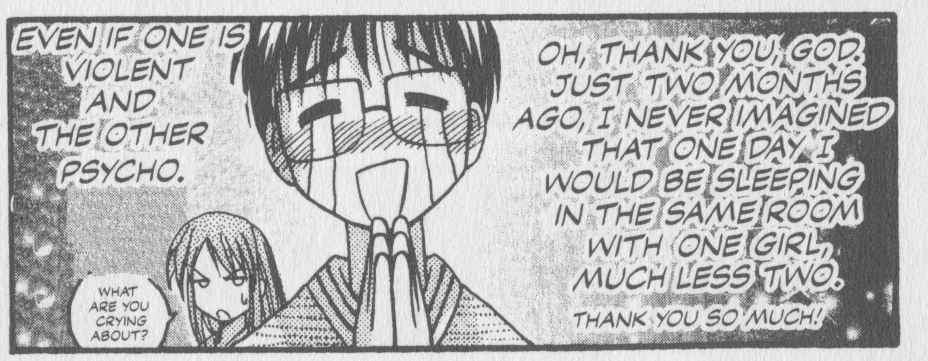
On a similar note, it’s funny that Keitaro insinuates that, even though nothing naughty will happen – after all Kaolla is very much a minor, he’s excited that by having Kaolla and Naru in his room, he’s having something akin to a threesome. That, however, I would imagine to be more universal as it stems from a universal selfishness. The thought that, for example, two members of the opposite sex could be fulfilling two different sexual needs at once.
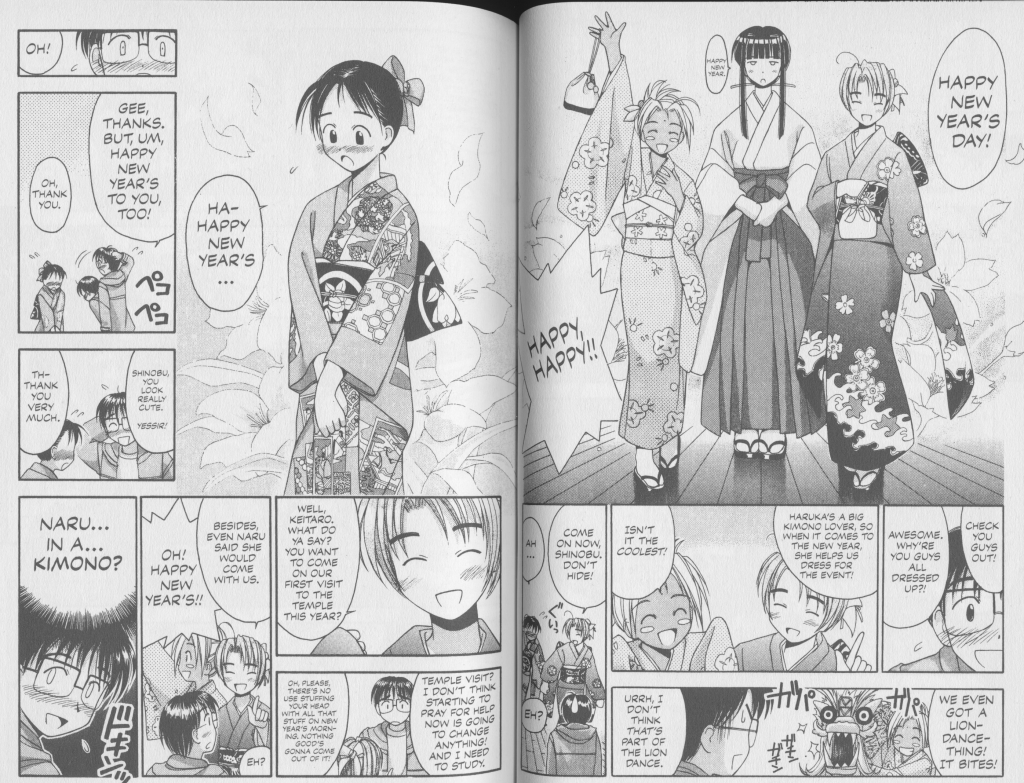
Keitaro’s diasappointment at not seeing Naru in a kimono was interesting to me because I’d always assumed that the West over-fetishized kimonos due to their being exotic. As a generalization we, in the West, already sexualize the East with all kinds of assumptions (probably born of film, pornography, and whore houses hundreds of years ago) that Asian women are hyper-sexual. I’ve heard second-hand of someone in America who said, with a straight face, that Asian women are taught by their mothers how to sexually please their future husbands. These ridiculous statements probably have their origins in the sex scrolls that were used hundreds of years ago as sexual education for a woman who was about to be married off. At any rate, I assumed that since kimonos also come from the East that we viewed them as a sexual bit of clothing. However, the implication of Keitaro’s reactions is that the Japanese themselves see the kimono as an outfit they’d like to see a woman wear. I can see the reasons, of course. It’s not too dissimilar from that of a skirt and combines the sexiness of a bathrobe with the elaborateness of clothes you’d wear outside. So, way to surprise me there, Akamatsu!
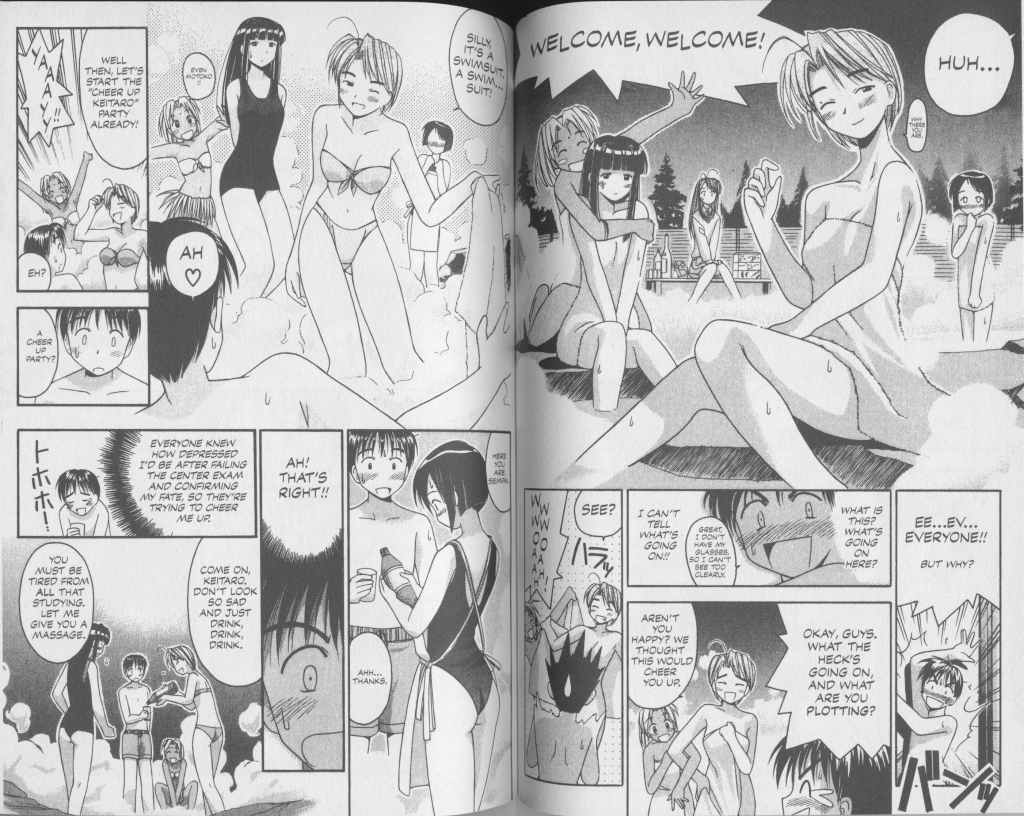
This scene is clearly a bit of fan service although I could MAYBE see something like this happening among misguided friends or at least as a scene in an American comedy. So, the girls know that Keitaro is a 19 year old virgin and that, like any dude, he’d love to see any of them naked. So, when they think he’s failed the test and Kitsune thinks he might even be suicidal, they decide to show him that life isn’t that bad, by inviting him out with them to the baths while they wear bathing suits. There’s clearly some grossness to it if you start to think about it as real life rather than a bit of fan service in a comic book. Again, for this to happen in real life would be extremely misguided – it’s almost akin to a bit of sympathy sex. And I do know, second-hand, of some friends who’ve done stuff like that but it’s not regarded as the healthiest of behavior. Anyway, I chose to see this scene as being more of a product of the fact that this is a comic book and less an indication of what people would do for each other sexually in Japan.
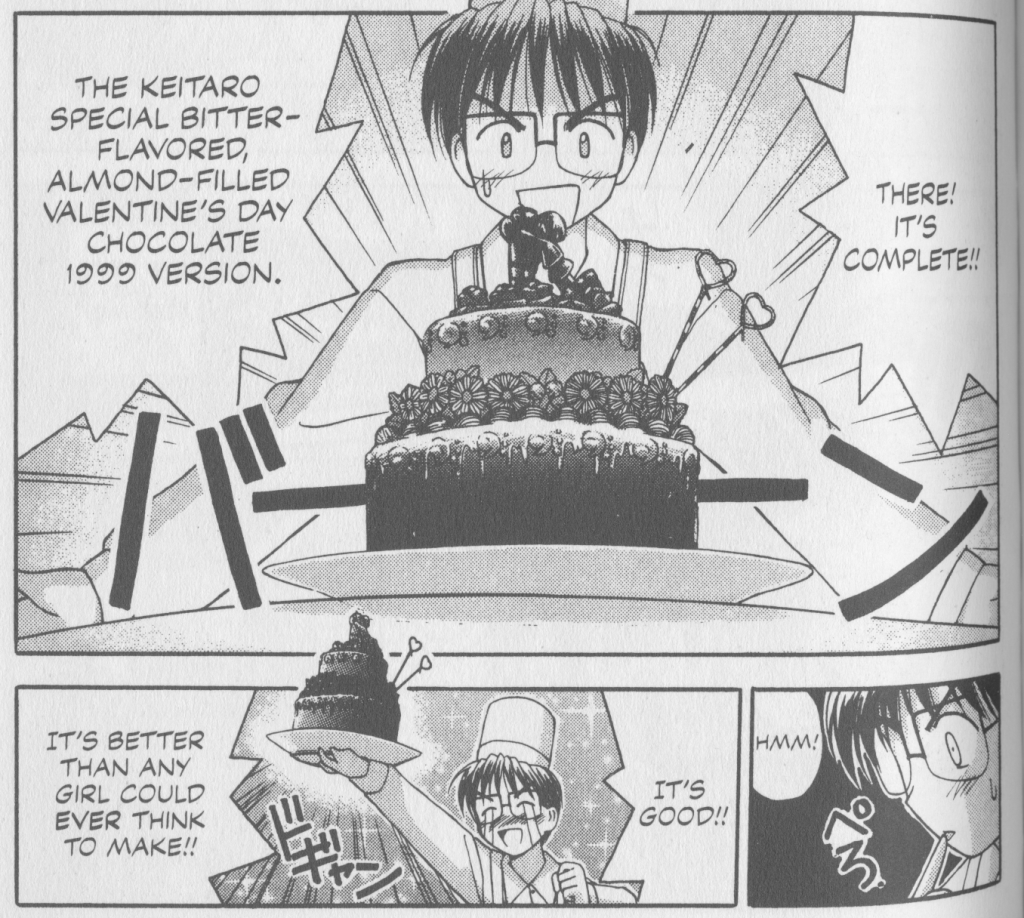
As I mentioned in the first post, Keitaro is quite effeminate in everything but his sex drive. Or rather, he is nothing that a man is supposed to be. This book continues that thread during the Valentine’s Day story. Keitaro doesn’t want to look like a loser who didn’t get any chocolate from any girls so over the years he’s made his own chocolate cake. And he’s gotten so good at it that it rivals anything a woman could make. So he’s taking on a female role in that he’s making baked goods (also a female stereotype in America) and he’s also embodying the female by giving it to himself. It’s a great metaphor for the fact that his only sexual action is self-provided (again see the first entry in this series). And the two women who are the least feminine – Naru and Motoko have comically bad gifts. Naru’s is malformed (other girls comment on how ugly it looks) and Motoko gives Keitaro BAKING CHOCOLATE. Which, as Keitaro correctly remarks, is not for consumption. I’m not a chocolate person, but Danielle tells me that baking chocolate takes horrible until it’s baked into something. Poor Shinobu, who is the model stereotypical woman, gives him a nicely wrapped chocolate heart that looks beautiful, but is still crappy when compared to his elaborate cake.
And that concludes book two. As I speculated, it’s quite a bit shorter than the previous entry (1/3 as long). As I write this, I’ve finished with my notes for book three and am about to start reading book four. However, I may take a break for a week or two to write some articles on American comics. At any rate, see you next week!
I’ve seen the kimono thing in other Japanese media too (video games, anime, etc.). I would compare it to, say, any excitement at seeing a person dress in a culturally significant article of clothing. Like how we get excited to wear guayaberas or how Danielle’s family views traditional Vietnamese clothing (or an Indian family would only wear saris for special cultural events).
Good point although when the post on Volume 5 comes out there may be some reason to re-evaluate your comment. Stay “tuned”!
[…] I mentioned to Dan in Part 2 of this series, perhaps there’s a bit more to Keitaro’s […]